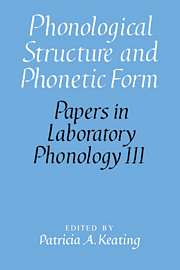Book contents
- Frontmatter
- Contents
- List of contributors
- Acknowledgments
- 1 Introduction
- I Intonation
- II Syllables
- III Feature Theory
- 12 The phonetics and phonology of Semitic pharyngeals
- 13 Possible articulatory bases for the class of guttural consonants
- 14 Phonetic evidence for hierarchies of features
- 15 Do acoustic landmarks constrain the coordination of articulatory events?
- IV Phonetic Output
- Index of subjects
- Index of names
15 - Do acoustic landmarks constrain the coordination of articulatory events?
Published online by Cambridge University Press: 26 February 2010
- Frontmatter
- Contents
- List of contributors
- Acknowledgments
- 1 Introduction
- I Intonation
- II Syllables
- III Feature Theory
- 12 The phonetics and phonology of Semitic pharyngeals
- 13 Possible articulatory bases for the class of guttural consonants
- 14 Phonetic evidence for hierarchies of features
- 15 Do acoustic landmarks constrain the coordination of articulatory events?
- IV Phonetic Output
- Index of subjects
- Index of names
Summary
Over the last few years, research in phonology and phonetics has begun to investigate the coordination of articulatory events (or gestures) in speech – describing the coordinative patterns that characterize particular phonological structures and developing principles that underlie the patterns. In his paper, Stevens proposes some enrichments to the theory of distinctive features designed to allow the theory to come to grips with aspects of the coordination problem. It is the account of coordination that emerges from his proposal that I will evaluate critically in these remarks.
Specifically, Stevens proposes that articulator-bound features (those that specify the movement of a particular articulator in forming and releasing a constriction) are divided into two types: primary and secondary (with a given segment typically having at most one primary feature). Formation and release of a constriction using the primary articulator is seen as creating an acoustic “landmark.” In the case of [consonantal] segments, this landmark is an acoustic discontinuity involving rapid spectral change. The coordinative principle is that secondary features must be coordinated with respect to the primary ones such that the acoustic evidence for the secondary features appears near the primary feature's acoustic landmark, on both sides of the discontinuity. The motivation for this is that “acoustic properties signaling the identity of the primary articulator depend on the positioning of secondary articulators” (section 14.4). Thus, Steyens seems to be suggesting that it is easier for the listener to sort out the interdependent acoustic influences of the entire ensemble of features when they are localized near these critical points.
- Type
- Chapter
- Information
- Phonological Structure and Phonetic Form , pp. 259 - 264Publisher: Cambridge University PressPrint publication year: 1994
- 2
- Cited by



